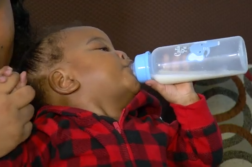SEATTLE, Wash. (Ivanhoe Newswire) – Studies have shown that organ transplant candidates and recipients have up to a four times increased risk of developing cancer. Those patients typically face multiple doctors and diagnoses, which often conflict with one another. However, one clinic has developed a new, unified approach to treating patients.
Transplant nephrologist at the University of Washington and Fred Hutchinson Cancer Center, Dr. Christopher Blosser, is on a mission to redefine healthcare for transplant patients diagnosed with cancer.
“People have a much higher risk of cancer in the setting of organ failure or organ transplant, and oftentimes, their care is fragmented or siloed,” Dr. Blosser says.
Siloed is referring to the different doctors a patient will see for each diagnosis. Typically, the physicians don’t consult with one another, which can lead to conflicting treatments.
“That doesn’t provide the best chance for them to do well,” he adds.
And that is why Dr. Blosser created the Cancer and Organ Transplant Clinic – a collaboration between the Fred Hutchinson Cancer Center and the University of Washington in Seattle.
“The Cancer and Organ Transplant Clinic is the first-of-its-kind multidisciplinary Clinic that provides personalized care for people who have cancers before or after an organ transplant.” Dr. Blosser explains.
Both a cancer specialist and transplant doctor meet with the patient to determine together the best course of treatment. The results have been transformational for patients. Dr. Blosser also created, in conjunction with the clinic, “The Center for Innovations in Cancer and Transplant.”
Dr. Blosser says it has, “The only patient level national registry to address why people develop cancers to a greater extent in the midst of organ failure.”
The Cancer and Organ Transplant Clinic aims to reach as many patients as possible outside of its Seattle area through telemedicine. For his part, Dr. Blosser is licensed in Washington and is in the process of becoming licensed in other states such as Alaska, Montana, Idaho, and Oregon. He says the more people they can reach, the better.
Contributors to this news report include: Jennifer Winter, Producer; Joe Alexander Short, Videographer; Roque Correa, Editor.
To receive a free weekly e-mail on medical breakthroughs from Ivanhoe, sign up at: http://www.ivanhoe.com/ftk
Sources:
National Library of Medicine
MEDICAL BREAKTHROUGHS
RESEARCH SUMMARY
TOPIC: CANCER & ORGAN TRANSPLANT CLINIC
REPORT: MB #5255
BACKGROUND: Organ transplants and their relation to cancer are connected due to the complex nature of the immune system and the use of immunosuppressive drugs to prevent organ rejection. Organ transplants have been life-saving procedures for many patients with end-stage organ failure. However, they also carry certain risks, and one significant concern is the development of cancer post-transplant. People who receive organ transplants have a risk of developing 32 different cancers. The most common kinds of cancer among transplant receivers were non-Hodgkin lymphoma, lung cancer, liver cancer, and kidney cancer. Transplants can directly put you at greater risk for disease from immunosuppressive medications, increased susceptibility to medications, and pre-existing conditions. Twenty percent of transplant patients will develop at least one cancer after 10 years of immunosuppressive therapies.
(Sources: https://www.nih.gov/news-events/nih-research-matters/organ-transplants-cancer-risk
https://academic.oup.com/jnci/article/99/6/421/2522533
DIAGNOSING: Diagnosing cancer in transplant patients requires a proactive and vigilant approach due to their increased risk compared to the general population. Regular monitoring and early detection are crucial to improve the chances of successful treatment. Some of the key aspects of diagnosing a patient with a failed transplant with cancer are regular screenings such as CT scans, MRIs, blood tests, and ultrasounds. Post-Transplant Lymphoproliferative Disorder Monitoring, skin examinations, pap smears, mammograms, colonoscopies, bone marrow biopsies, and patient education are key aspects as well. Regular doctor visits and screening schedules are essential for long-term care of patients.
(Source: https://www.ncbi.nlm.nih.gov/pmc/articles/PMC3685882/
https://www.ncbi.nlm.nih.gov/books/NBK537256/
NEW TECHNOLOGY: The Fred Hutchinson Cancer Center and the University of Washington in Seattle have collaborated to create a cancer and transplant clinic. It is a multidisciplinary clinic that offers care for people experiencing cancer and previous transplants. Patients meet with both cancer doctors and transplant specialists to determine the best course of action for care. The center aims to research further into the correlation between transplant and cancer diseases.
(Source: https://www.seattlecca.org/treatments/cancer-and-organ-transplant-clinic
FOR MORE INFORMATION ON THIS REPORT, PLEASE CONTACT:
Heather Platisha
If this story or any other Ivanhoe story has impacted your life or prompted you or someone you know to seek or change treatments, please let us know by contacting Marjorie Bekaert Thomas at mthomas@ivanhoe.com




